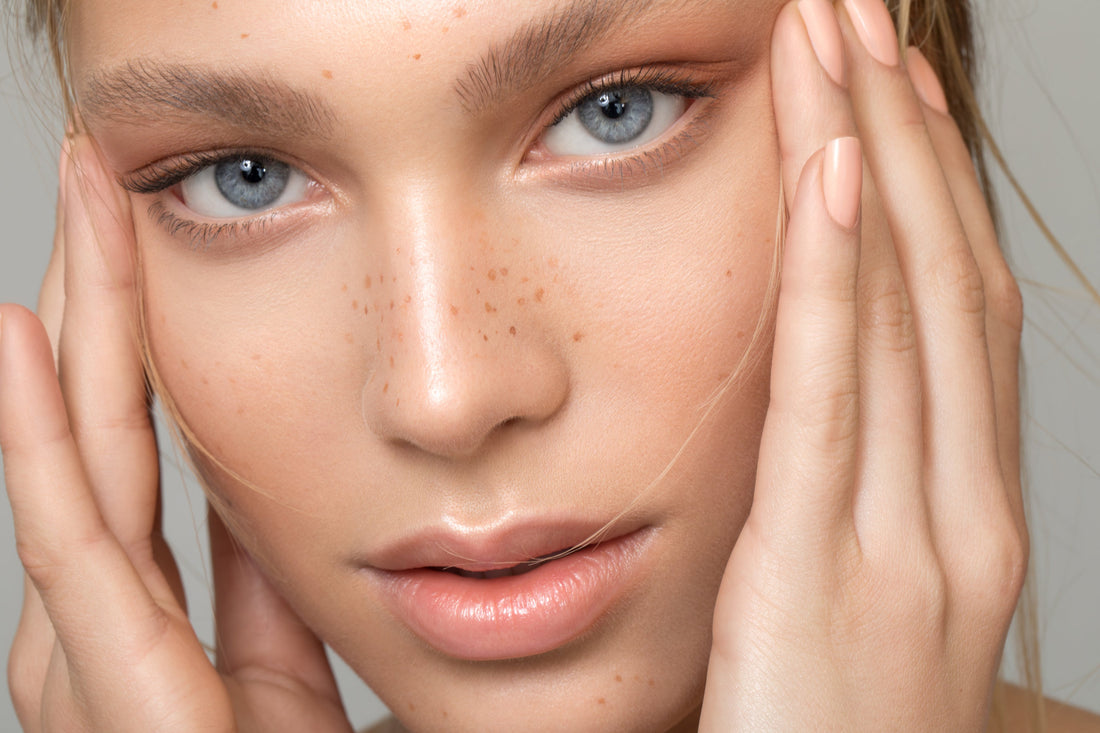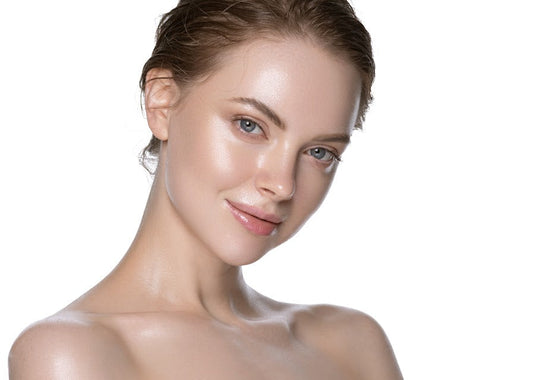
Is Hyaluronic Acid Good For Acne?
Medically reviewed by Dr Shamsa Kanwal - Dermatologist
Written by K. Muirhead
Updated on December 24, 2024
Hyaluronic acid is a staple in the skincare industry, and for good reason. This all-rounder ingredient can help to keep our skin plump, hydrated, and smooth. But is it also suitable for acne-prone skin? Does it contribute to clearing breakouts or is it just another trend in skincare?
Let’s take a look at this popular ingredient, starting with the basics, and finding out whether it is suitable for acne-prone skin.
What Is Hyaluronic Acid?

Hyaluronic acid is a sugar molecule that is naturally found in the body, such as in the eyes, joints, and skin. It’s a naturally occurring humectant, which means it attracts water, working to hydrate, lubricate, and moisturize [1].
When used as a skincare ingredient, it can draw moisture into the skin, since it can bind a large number of water molecules [2]. This is why hyaluronic acid can help plump, and hydrate our skin, and visibly reduce the appearance of any fine lines and wrinkles. It also helps improve the skin’s flexibility and supports a healthy moisture barrier.
Hyaluronic acid is found in abundance when we’re younger and helps maintain hydration alongside collagen. However, hyaluronic acid levels begin to dip as we get older, contributing to dehydration and visible signs of aging.
How Does Hyaluronic Acid Work?
Hyaluronic acid’s main function is to maintain moisture in the skin. When applied topically, it attracts water from the atmosphere and binds it to the skin’s surface, thus increasing hydration levels.
It also supports the skin’s natural barrier, helping our skin fight against external irritants, including acne triggers. Its moisturizing properties promote skin elasticity, ensuring that it remains smooth and plump [3].
Below is a flowchart breaking down how Hyaluronic Acid works to keep our skin hydrated, plump, and balanced.

Can Hyaluronic Acid Cause Acne?
Hyaluronic acid in skincare sounds great in theory, but is there a risk that it could make our acne worse? The good news is that hyaluronic acid is generally safe for acne-prone skin. However, the other ingredients in our hydrating products may not be quite so gentle.
Ingredients such as coconut oil, lanolin, shea butter, or certain additives used in lotion can all contribute to clogs in the skin. It’s also possible that—while hyaluronic acid is safe for sensitive skin—you may be sensitive to other ingredients in a formulation, which could cause inflammation.
Even if hyaluronic acid itself is non-comedogenic, other ingredients in your products might not be. That’s why it’s always smart to check your products for pore-clogging ingredients, especially if you’re dealing with breakouts or sensitive skin.
Does Hyaluronic Acid Help Acne?
The good news is that hyaluronic acid can absolutely help with acne! In fact, beyond simply hydrating, hyaluronic acid can be considered an important part of our acne-fighting routine.
However, it’s worth noting that hyaluronic acid itself isn’t an acne treatment, and its success relies on how it’s formulated and used in a comprehensive routine. But before we get into that, let’s address what hyaluronic acid does for acne and why its unique properties make it suitable for acne-prone skin.
- Balances Oils
When the skin is dehydrated, it compensates by producing more oil, which can clog pores and lead to breakouts. Hyaluronic acid helps maintain hydration, supporting skin balance and reducing the risk of excess oil production.
In a recent study to determine the effectiveness of hyaluronic acid, the researchers conducted a clinical trial on 20 people with oily skin, and the side treated with hyaluronic acid saw a significant reduction in sebum production compared to the untreated side [4]. This study revealed that hyaluronic acid decreases the size of sebaceous glands, and hence reduces chances for pore clogging.
- Safe for Sensitive Skin
Hyaluronic is gentle and, in general, extremely well-tolerated by all skin types. This means that it can be used on breakout-prone skin, without the risk of worsening irritation or redness.
- Non-Comedogenic
Hyaluronic acid is non-comedogenic, meaning it works without clogging pores and contributing to further breakouts.
- Plays Well With Others
In general, hyaluronic acid is safe to use alongside other acne-fighting ingredients, like green tea extract, zinc, and niacinamide. It can be safely layered and absorbed quickly and may help relieve redness or dryness that comes with other acne treatments.
Does Hyaluronic Acid Help With Acne Scars?
If you have mild to moderate atrophic acne scars (depressed, sunken, pitted scars), hyaluronic acid can surely help. However, it’s important to note that its effectiveness is not primarily through topical application. Instead, hyaluronic acid is commonly used in dermal fillers, which can be injected by a professional directly into deeper acne scars.
It works by filling in any divots or pockmarks to create a smooth surface, but in general, this treatment should only be pursued once the skin is completely healed. If you have hypertrophic (raised, thick, and red scars), or keloid scars (raised, thick, and irregular scars), dermal fillers might not work, and your aesthetician might suggest steroid injections.
A study was conducted on 12 patients with moderate to severe acne scarring. Each of these patients was given microinjections of 20 mg/mL hyaluronic acid gel in their scars. Immediate results were visible in all patients, and all 12 were satisfied with the results. No adverse side effects were seen other than pinpoint bleeding in some.

Hyaluronic Acid Benefits for Acne
Hyaluronic acid can be beneficial for acne-prone skin for several reasons. While it doesn’t directly treat acne, it helps maintain a balanced skin environment. Here’s how it can support acne management:
-
Hydration: One of the primary roles of hyaluronic acid is to attract and retain moisture. This hydration supports skin elasticity and reduces dryness, which can occur when other acne treatments, such as retinoids or benzoyl peroxide, are used.
-
Sebum Regulation: : Overly dry skin can trigger compensatory sebum production, potentially leading to clogged pores and breakouts. By keeping skin well-moisturized, hyaluronic acid may help prevent excessive oil production.
- Soothing Effects: Hyaluronic acid also has soothing and anti-inflammatory properties, which can help calm irritated or inflamed skin, common in acne-prone individuals. This may reduce redness and swelling associated with active breakouts.
-
Promotes Healing: It can also support the healing of acne scars and blemishes by improving the skin's moisture barrier and enhancing cell turnover, which may help fade scars over time.
Other Benefits of Hyaluronic Acid For Acne
- Anti-aging: Hyaluronic acid is a powerful anti-aging ingredient. Its ability to plump the skin can smooth fine lines and wrinkles, promoting a more youthful appearance.
- Eczema and Sensitive Skin: It’s gentle enough for sensitive and eczema-prone skin, providing hydration without causing irritation.
- Dewy Finish: It creates a youthful, dewy glow by locking in moisture and improving skin texture.
How To Add Hyaluronic Acid To Your Acne-Prone Skincare Routine?
Hyaluronic acid is available in a wide range of products, from facial cleansers and face masks to makeup. However, the most common—and most potent—way to add this plumping ingredient is with a hyaluronic acid serum.
You can choose a simple hyaluronic acid serum, a multi-active formula, or a hyaluronic-infused moisturizer. Other than that, you can also include hyaluronic acid masks in your weekly routine.
If you prefer a multifunctional formula that pairs hydration with barrier support, Rush Hour Serum for sensitive skin is a great all-in-one option. It’s powered by our proprietary GLOW7™ complex, designed to hydrate, calm, brighten, and even tone, perfect for acne-prone, reactive skin.
Hyaluronic acid goes well with almost all active ingredients, so you can easily pair it up with niacinamide, exfoliants, or even retinol. Do not forget to follow up with your sunscreen in the morning and moisturizer at night.
Here Are the Steps On How to Use Hyaluronic Acid for Acne-Prone Skin:
1. Cleanse Your Skin First
- Step 1: Start with a gentle, non-drying cleanser that won’t strip your skin of natural oils. Choose a mild, sulfate-free cleanser suited for acne-prone skin to avoid irritating your skin further.
- Why: Clean skin ensures that the hyaluronic acid is able to penetrate better and work effectively.
2. Apply Hyaluronic Acid on Damp Skin
- Step 2: After cleansing, apply a few drops of hyaluronic acid while your skin is slightly damp (not dripping wet). The dampness helps it attract and hold water more effectively. Hyaluronic acid is a humectant, which means it draws moisture from its surroundings, so applying it on damp skin will help lock in that moisture.
- Why: Applying it on lightly damp skin enhances its hydration effects and prevents it from drawing moisture out of your skin, which could lead to dryness.
3. Use a Toner (Optional)
- Step 3: If you use a toner, apply it before hyaluronic acid. Opt for a toner that doesn’t contain alcohol, as alcohol can dry out the skin. Hydrating toners with ingredients like glycerin or aloe vera work well.
- Why: Toners help balance the skin’s pH and can provide additional moisture, ensuring better hydration when followed by hyaluronic acid.
4. Apply Hyaluronic Acid
- Step 4: Dispense 2-3 drops of your hyaluronic acid serum into your palms, and gently press it onto your damp face, focusing on areas that tend to be dry or have acne scars. Avoid rubbing; just press it into your skin.
- Why: Pressing it in gently will help your skin absorb the product more effectively. Avoid rubbing or massaging too vigorously, as this can irritate acne-prone skin.
5. Follow With a Moisturizer
- Step 5: After applying hyaluronic acid, seal in the moisture with a lightweight, non-comedogenic moisturizer. This step is important, especially for acne-prone skin, as it helps lock in hydration and maintain your skin’s moisture barrier.
- Why: Moisturizing after hyaluronic acid is essential to prevent your skin from losing the moisture that was just added. If you're using a treatment like benzoyl peroxide or salicylic acid, the moisturizer will help prevent excessive dryness or irritation.
6. Sun Protection (Morning Routine)
- Step 6: If you’re using hyaluronic acid in the morning, finish with a broad-spectrum sunscreen (SPF 30 or higher). Sun protection is crucial, especially if you're using other acne treatments like retinoids or acids, which can increase your skin's sensitivity to the sun. Reapply throughout the day if exposed to sunlight for extended periods.
- Why: Sunscreen helps protect your skin from UV damage, preventing hyperpigmentation or dark spots from worsening.
Potential Risks of Hyaluronic Acid Misuse
Despite its many benefits, hyaluronic acid can be misused, especially in dry environments, or low-humidity areas. This is because hyaluronic acid is a humectant, meaning it draws water from the atmosphere and delivers it to our skin. When there is not enough moisture in the air, like in low-humidity areas, it instead starts pulling water from deeper layers of your skin to hydrate the surface.
If applied excessively without the right moisturizer, it may draw moisture from the skin, leading to dehydration, dryness, and irritation. To avoid this, always ensure that hyaluronic acid is followed by a moisturizing product that locks in hydration. In dry climates, enhance hyaluronic acid’s effectiveness by pairing it with a hydrating mist or toner beforehand, ensuring your skin has ample moisture to draw from.
Comparative Analysis – Hyaluronic Acid Vs. Other Humectants
While hyaluronic acid can support the hydration of acne-prone skin, it is not an acne treatment on its own. In fact, its efficacy for any skin type comes down to how it's formulated. Hyaluronic acid products that contain glycerin—another humectant that can make up to 70% of certain serums—tend to yield better results.
Think of hyaluronic acid as a hydration booster, rather than a complete skincare solution. And, when examining the ingredients of a serum or moisturizer, make sure to avoid any comedogenic (likely to clog pores) ingredients.
When it comes to effective hydration, there are alternative ingredients that are worth considering. These include Saccharide Isomerate—a plant-derived humectant that can keep the skin hydrated for up to 72 hours—and squalene—a natural oil known for its hydrating and moisturizing benefits. Here’s a quick comparison of hyaluronic acid with other humectants, and how they all contribute to your skin health:
| Features | Hyaluronic Acid | Glycerin | Saccharide Isomerate | Squalane |
|---|---|---|---|---|
| Hydration Power | Draws in up to 1,000 times its weight in water | Less potent, draws moisture but not as effectively | Excellent hydration, particularly in dry climates where it forms a longer-lasting moisture bond | Moisturizes by mimicking the skin’s natural sebum |
| Skin Sensitivity | Gentle on sensitive skin | Generally gentle, but in high concentrations, it can feel sticky or cause irritation in some | Often used in sensitive-skin products | Extremely gentle, suitable for sensitive and acne-prone skin |
| Acne-Prone Skin | Non-comedogenic and lightweight | Non-comedogenic, but sticky texture may irritate acne | Good for hydration but may not be as effective as Hyaluronic Acid in acne treatments | Non-comedogenic, soothes irritation, and helps balance sebum production effectively |
| Healing Benefits | Supports wound healing and collagen production | Does not directly aid in healing but supports hydration for better skin recovery | Excellent for soothing and preventing moisture loss | Supports barrier repair, reduces redness, and soothes inflammation |
FAQS
Here are a few of the most frequently asked questions about hyaluronic acid for acne prone skin:
-
When should I use Hyaluronic Acid?
Hyaluronic acid should be applied to clean, slightly damp skin, before using a moisturizer. This way, moisture can be absorbed into the skin and effectively kept there for hydration. And for acne prone skin, opt for a lightweight, non-comedogenic moisturizer. Applying HA to damp skin is especially important in dry climates to avoid drawing moisture from deeper layers of the skin.
-
How often should you use Hyaluronic Acid if you have acne-prone skin?
Hyaluronic acid is gentle enough for daily use, or even twice a day—morning and night—based on personal preference. However, be mindful of layering Hyaluronic Acid with other active ingredients like strong exfoliating acids or retinoids, as these may irritate the skin if overused. Always ensure that accompanying products are non-comedogenic and pH-balanced to avoid compromising the skin barrier.
-
Which is better, salicylic acid or hyaluronic acid for acne?
Hyaluronic acid helps hydrate the skin, which can be beneficial when using drying acne treatments. Salicylic acid, on the other hand, helps unclog pores and reduce inflammation. These ingredients can complement each other when used properly in a skincare routine, with salicylic acid targeting acne and hyaluronic acid providing hydration.
-
Is hyaluronic acid good for popped pimples?
Yes, hyaluronic acid can help soothe and hydrate the skin after a pimple is popped. It won’t heal the pimple directly but can prevent dryness and support skin’s natural repair process.
Final Thoughts
With its ability to hydrate without clogging pores, hyaluronic acid is more than just a trend. Whether you have breakouts or are trying to manage acne-prone skin, hyaluronic acid is an ingredient that can help keep your skin hydrated, soothed, and happy. As always, for those with severe acne or scarring, consulting with a dermatologist is advised to explore the best treatment options, including professional interventions like dermal fillers.

 Hydration
Hydration
 Soothing
Soothing
 Radiance
Radiance
 Clarity
Clarity









